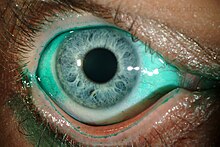
Back التهاب القرنية والملتحمة الجاف Arabic Quru göz sindromu Azerbaijani Sindrom suhih očiju BS Queratoconjuntivitis seca Catalan Syndrom suchého oka Czech Keratoconjunctivitis sicca German Ξηροφθαλμία Greek Queratoconjuntivitis seca Spanish Kuiv keratokonjunktiviit Estonian خشکی چشم Persian
| Dry eye syndrome | |
|---|---|
| Other names | Dry eye, keratoconjunctivitis sicca, dry eye disease (DED), keratitis sicca |
 | |
| Diffuse lissamine green staining in a person with severe dry eye[1] | |
| Specialty | Ophthalmology, Optometry |
| Symptoms | Dry eyes, irritation, redness, discharge, blurred vision[2] |
| Complications | Corneal scarring[2] |
| Causes | Contact lenses, meibomian gland dysfunction, pregnancy, Sjögren syndrome, vitamin A deficiency, LASIK surgery, antihistamines, hormone replacement therapy, antidepressants[2][3][4] |
| Treatment | Artificial tears, wrap around glasses, changing certain medications[2] |
| Medication | Ciclosporin, steroid eye drops[2] |
| Frequency | ~20%[5] |
Dry eye syndrome, also known as keratoconjunctivitis sicca, is the condition of having dry eyes.[2] Symptoms include dryness in the eye, irritation, redness, discharge, blurred vision, and easily fatigued eyes. Symptoms range from mild and occasional to severe and continuous.[3] Dry eye syndrome can lead to blurred vision, instability of the tear film, increased risk of damage to the ocular surface such as scarring of the cornea, and changes in the eye including the neurosensory system.[2][6]
Dry eye occurs when either the eye does not produce enough tears or when the tears evaporate too quickly.[2] This can be caused by age, contact lens use, meibomian gland dysfunction,[7] pregnancy, Sjögren syndrome, vitamin A deficiency, omega-3 fatty acid deficiency, LASIK surgery, and certain medications such as antihistamines, some blood pressure medication, hormone replacement therapy, and antidepressants.[2][3][4] Chronic conjunctivitis such as from tobacco smoke exposure or infection may also lead to the condition.[2] Diagnosis is mostly based on the symptoms, though a number of other tests may be used.[8] Dry eye syndrome occasionally makes wearing contact lenses impossible.[2]
Treatment depends on the underlying cause. Artificial tears are usually the first line of treatment. Wrap-around glasses that fit close to the face may decrease tear evaporation.[9] Looking carefully at the medications a person is taking and, if safe, altering the medications, may also improve symptoms if these medications are the cause. Some topical medications, or eye drops, may be suggested to help treat the condition. The immunosuppressant cyclosporine (ciclosporin) may be recommended to increase tear production and, for short term use, topical corticosteroid medications are also sometimes helpful to reduce inflammation.[6] Another treatment that is sometimes suggested is lacrimal plugs that prevent tears from draining from the surface of the eye.
Dry eye syndrome is a common eye disease.[3] It affects 5–34% of people to some degree depending on the population looked at.[5] Among older people it affects up to 70%.[10] In China it affects about 17% of people.[11] The phrase "keratoconjunctivitis sicca" means "dryness of the cornea and conjunctiva" in Latin.[12]
- ^ Critser B. "Lissamine green staining in keratoconjunctivitis sicca". Eye Rounds. The University of Iowa. Archived from the original on 7 August 2016. Retrieved 29 July 2016.
- ^ a b c d e f g h i j k "Facts About Dry Eye". NEI. February 2013. Archived from the original on 28 July 2016. Retrieved 29 July 2016.
- ^ a b c d Kanellopoulos AJ, Asimellis G (2016). "In pursuit of objective dry eye screening clinical techniques". Eye and Vision. 3: 1. doi:10.1186/s40662-015-0032-4. PMC 4716631. PMID 26783543.
- ^ a b Meadows M (May–June 2005). "Dealing with Dry Eye". FDA Consumer Magazine. 39 (3). U.S. Food and Drug Administration: 8–9. PMID 16127813. Archived from the original on 23 February 2008.
- ^ a b Messmer EM (January 2015). "The pathophysiology, diagnosis, and treatment of dry eye disease". Deutsches Ärzteblatt International. 112 (5): 71–81, quiz 82. doi:10.3238/arztebl.2015.0071. PMC 4335585. PMID 25686388.
- ^ a b Liu SH, Saldanha IJ, Abraham AG, Rittiphairoj T, Hauswirth S, Gregory D, et al. (21 October 2022). Cochrane Eyes and Vision Group (ed.). "Topical corticosteroids for dry eye". Cochrane Database of Systematic Reviews. 2022 (10): CD015070. doi:10.1002/14651858.CD015070.pub2. PMC 9586197. PMID 36269562.
- ^ Puro DG (June 2020). "How goblet cells respond to dry eye: adaptive and pathological roles of voltage-gated calcium channels and P2X7 purinoceptors". American Journal of Physiology. Cell Physiology. 318 (6): C1305 – C1315. doi:10.1152/ajpcell.00086.2020. PMC 7311746. PMID 32348177.
- ^ Tavares F, Fernandes RS, Bernardes TF, Bonfioli AA, Soares EJ (May 2010). "Dry eye disease". Seminars in Ophthalmology. 25 (3): 84–93. doi:10.3109/08820538.2010.488568. PMID 20590418. S2CID 207474207.
- ^ "Eye Drops for Dry Eyes | Science-Based Medicine". sciencebasedmedicine.org. 4 May 2021. Archived from the original on 4 November 2022. Retrieved 4 November 2022.
- ^ Ding J, Sullivan DA (July 2012). "Aging and dry eye disease". Experimental Gerontology. 47 (7): 483–490. doi:10.1016/j.exger.2012.03.020. PMC 3368077. PMID 22569356.
- ^ Liu NN, Liu L, Li J, Sun YZ (2014). "Prevalence of and risk factors for dry eye symptom in mainland china: a systematic review and meta-analysis". Journal of Ophthalmology. 2014: 748654. doi:10.1155/2014/748654. PMC 4216702. PMID 25386359.
- ^ Firestein GS (2013). Kelley's textbook of rheumatology (9th ed.). Philadelphia: Elsevier/Saunders. p. 1179. ISBN 978-1437717389. Archived from the original on 8 September 2017.